While you are reading these lines, somewhere far away (or maybe not so far) from you, silent killers are furrowing the seas, hiding under the thickness of the water. They are huge, powerful and deadly, capable of hiding in the depths for months, in order to one day deliver the decisive blow.
No, we are not talking about a new horror movie or a documentary video “from the life of sharks”. In this article, you, dear readers, will find the answer to the question of which submarine is worthy of the title of the largest in the world, and which countries can afford to build such steel giants.
And just recently we introduced readers to the 10 largest ships in the world.
10. "Astyut" - length: 97 m, width 11.3 m
 The tenth largest submarine in the world, it is the largest, most advanced and most powerful submarine ever operated by the British Royal Navy, measuring 97 metres long and 11.3 metres wide.
The tenth largest submarine in the world, it is the largest, most advanced and most powerful submarine ever operated by the British Royal Navy, measuring 97 metres long and 11.3 metres wide.
There are three submarines in the Astute class, with four more under construction. In case of combat, the submarine is armed with six 48 missiles or torpedoes, Tomahawk cruise missiles, Harpoon anti-ship missiles and 533 mm torpedo tubes (TT).
In 2012, Astutes demonstrated their ability to launch Tomahawk missiles by successfully firing two missiles from the Gulf of Mexico and accurately hitting targets at a test range in North Florida.
9. Seawolf – 107.6 x 12.2 m
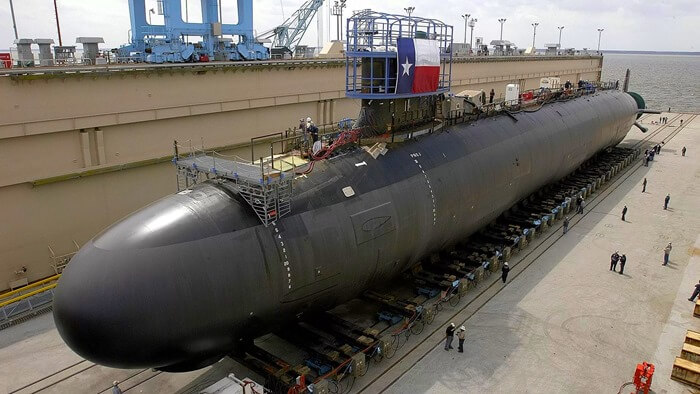 This series of nuclear submarines was built by order of the US Navy in 1989-1998. The Seawolves were a response to the construction of submarines in the Soviet Union under the Project 971 Shchuka-B. A total of three ships were built, although it was originally planned that the series would include 12 submarines.
This series of nuclear submarines was built by order of the US Navy in 1989-1998. The Seawolves were a response to the construction of submarines in the Soviet Union under the Project 971 Shchuka-B. A total of three ships were built, although it was originally planned that the series would include 12 submarines.
The Seawolfs are 107.6 meters long and 12.2 meters wide, respectively. These submarines are powered by a single nuclear reactor and have a speed of 18 knots.
The armament installed on the American submarine includes eight 660-mm torpedo tubes, 50 torpedoes or missiles and 50 Tomahawk cruise missiles.
8. Project 945A “Condor” – 110.5 x 12.2 m
 The first, but not the only one among the largest submarines in Russia. Today, two "Condors" are in operation, 110.5 meters long and 12.2 meters wide.
The first, but not the only one among the largest submarines in Russia. Today, two "Condors" are in operation, 110.5 meters long and 12.2 meters wide.
The hull of the Condor-class submarines is made of lightweight and durable titanium, which allows the submarine to reach greater depths and reduces the noise level. In terms of armament, the Condors boast six 533 mm torpedo tubes, 40 torpedoes, S-10 Granat cruise missiles, and eight Igla-1 and Igla MANPADS launchers.
7. Project 971 "Shchuka-B" - 110.3 x 13.6 m
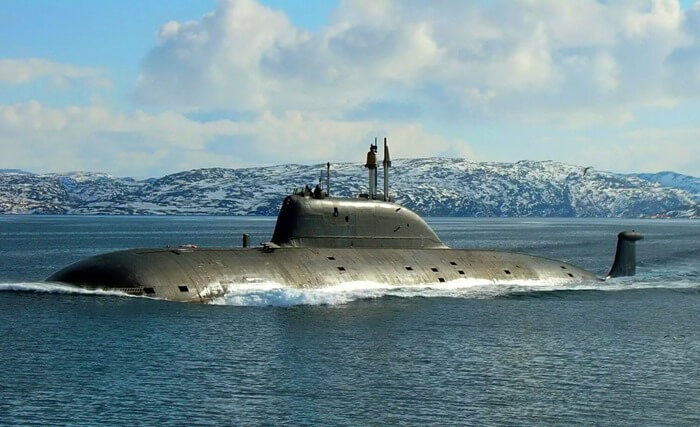 The Soviet Union can be criticized for many things, but not for its weak army and navy. It was in the USSR that one of the largest nuclear submarines in the world, the Shchuka-B, was built. Unlike the Condors, the hull of this submarine is made of alloy steel. The length of the formidable steel "fish" is just over 110 meters, and the width is over 13 meters.
The Soviet Union can be criticized for many things, but not for its weak army and navy. It was in the USSR that one of the largest nuclear submarines in the world, the Shchuka-B, was built. Unlike the Condors, the hull of this submarine is made of alloy steel. The length of the formidable steel "fish" is just over 110 meters, and the width is over 13 meters.
The Shchuka-B project (1983-2001) was carried out at the Sevmash engineering plant in Severodvinsk and was revised several times. The improved boats were called Improved Akula or Akula-II by Western militaries. The most modernized submarine, the K-335 Gepard, was called Akula-III in the West. The Indian Navy also has one of the modernized Shchuka-Bs (K-152 Nerpa). It lacks the SOX system and the ability to launch acoustic countermeasures.
In 2017, four Shchuka-B class submarines remained in service. Each of them is equipped with four 650 mm torpedo tubes, four 533 mm TA, a Kalibr-PL IRS and a Strela-3M MANPADS.
6. "Triomphan" - 138 x 12.5 m
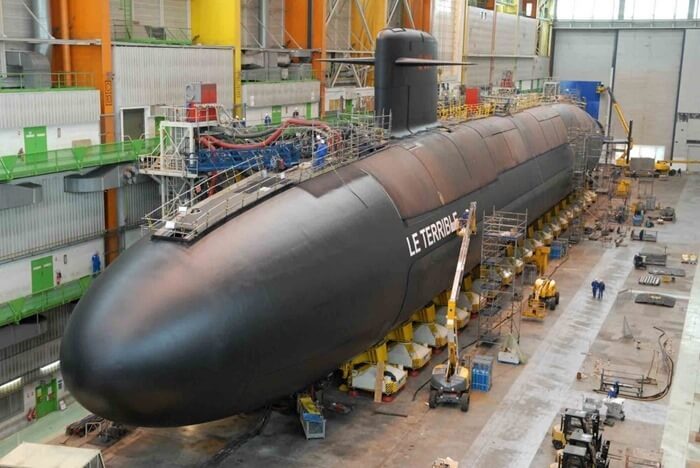 Sunny France is one of the few European countries that can afford to build a huge, heavy and expensive submarine. From 1989 to 2009, four Triomphant-class submarines were built, measuring 138 metres long and 12.5 metres wide. Initially, six units were planned, but the French Navy's plans changed due to the collapse of the Soviet Union.
Sunny France is one of the few European countries that can afford to build a huge, heavy and expensive submarine. From 1989 to 2009, four Triomphant-class submarines were built, measuring 138 metres long and 12.5 metres wide. Initially, six units were planned, but the French Navy's plans changed due to the collapse of the Soviet Union.
The Triumphans are armed with four 533 mm torpedo tubes, 10 torpedoes, 8 Exocet SM39 cruise missiles, which are launched from the TA, and M45 and M51 missiles.
5. "Vanguard" - 149.9 x 12.8 m
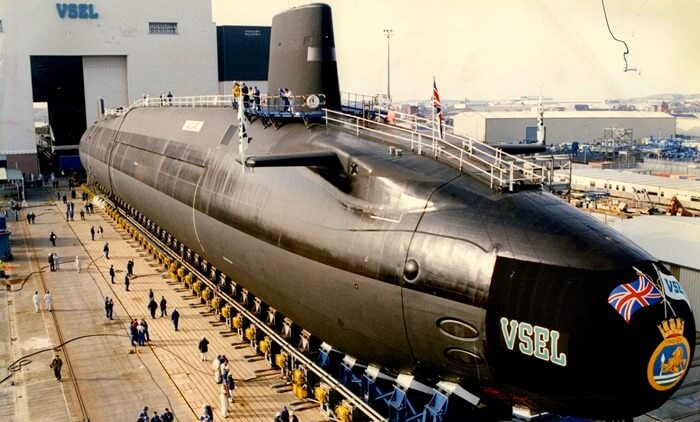 The pride of the British fleet, over 149 meters long and over 12 meters wide. The Vanguard series includes four nuclear submarines, the history of which began in the 90s of the twentieth century. They were built in a huge covered slipway (a workshop for construction or repair) 260 meters long and 58 meters wide. Its dimensions allow building not only nuclear submarines, but also destroyers with guided missile weapons.
The pride of the British fleet, over 149 meters long and over 12 meters wide. The Vanguard series includes four nuclear submarines, the history of which began in the 90s of the twentieth century. They were built in a huge covered slipway (a workshop for construction or repair) 260 meters long and 58 meters wide. Its dimensions allow building not only nuclear submarines, but also destroyers with guided missile weapons.
Initially, it was planned to assemble 6 or even 7 submarines, but with the collapse of the USSR, Great Britain and other NATO countries no longer needed a large number of submarines as one of the means of nuclear deterrence.
The Vanguards carry four 533mm TAs, 16 Trident II D5 ballistic missiles and Spearfish or Tigerfish remote-controlled torpedoes.
4. “Delta” - 167.4 x 11.7 m
 This is the collective designation for four types of strategic nuclear submarines assembled in the USSR. Project code names:
This is the collective designation for four types of strategic nuclear submarines assembled in the USSR. Project code names:
- "Moray eel".
- "Murena-M".
- "Squid".
- "Dolphin".
The length of the latest modification, the "Dolphin", is 167.4 meters, and the width is 11.7 meters. This great steel fish was commissioned in December 1984. Of the seven "Dolphins" built, five are still listed in the Russian Navy.
The Dolphins' enemies will be in trouble, as they are equipped with four 533mm TA, 12 torpedoes, 16 ballistic missiles, and 4 to 8 Igla and Igla-1 MANPADS.
3. “Ohio” – 170.7 x 12.8 m
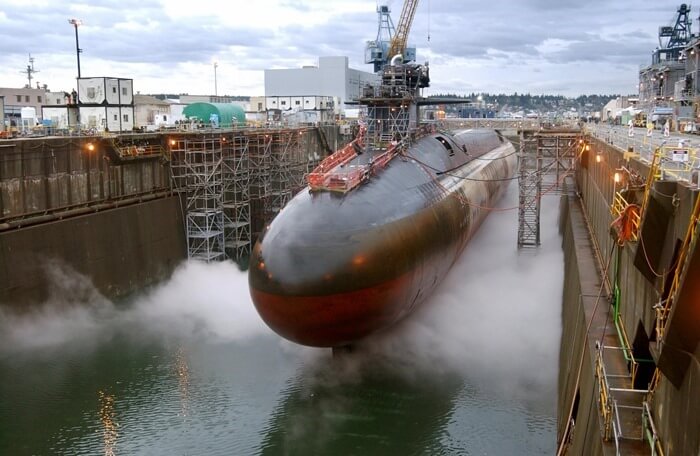 These giants are the largest submarines in the United States and the backbone of the American strategic offensive nuclear forces. They regularly have to carry out combat patrols, spending 60% of time at sea. The size of the Ohio is 170.7 meters and 12.8 meters (length and width, respectively).
These giants are the largest submarines in the United States and the backbone of the American strategic offensive nuclear forces. They regularly have to carry out combat patrols, spending 60% of time at sea. The size of the Ohio is 170.7 meters and 12.8 meters (length and width, respectively).
The first submarine in the series was commissioned in November 1981. All other submarines were named after American states, with the exception of USS Henry M. Jackson, which was named after a senator.
These underwater behemoths are capable of carrying over twenty Trident II missiles and over 150 Tomahawk cruise missiles. Their armament also includes four 533 mm torpedo tubes.
2. Project 955 "Borey" - 170 x 13.5 m
 The second largest submarine is again a Russian development, one of the most advanced in the world. The Borey project began in 2011, and in May 2018 it became known that 14 ships of this type are planned to be built by 2027.
The second largest submarine is again a Russian development, one of the most advanced in the world. The Borey project began in 2011, and in May 2018 it became known that 14 ships of this type are planned to be built by 2027.
In the future, it is Borey that will replace the first and fourth numbers on our list.
The submarine measures 170 meters in length and 13.5 meters in width. This shapely, deadly beauty can travel underwater at a speed of 29 knots, and is equipped with six 533 mm torpedo tubes, six 324 mm hydroacoustic countermeasures, torpedoes, torpedo missiles and cruise missiles (including Oniks and Kalibr), as well as 16 Bulava launchers.
1. Project 941 "Akula" - 172.8 x 23.3 m
 Known to the West as the Typhoon class and to Russian sailors as the Akula class, these majestic steel giants were built to counter the American Ohio class submarines during the Cold War.
Known to the West as the Typhoon class and to Russian sailors as the Akula class, these majestic steel giants were built to counter the American Ohio class submarines during the Cold War.
At 172.8 meters long and 23.3 meters wide, these monsters, with a surface and underwater displacement of 23,200 tons and 48,000 tons respectively, were larger than their American submarine competitors. Their height (26 meters) is comparable to the height of a nine-story building.
Essentially, the Sharks' mission was to create a nuclear apocalypse in the West if the Cold War turned hot.
 The world's largest nuclear submarine received its predatory nickname thanks to the image of a shark that was painted on it before its first launch in September 1980.
The world's largest nuclear submarine received its predatory nickname thanks to the image of a shark that was painted on it before its first launch in September 1980.
 Inside the lightweight hull of the huge submarine are five habitable hulls. In case of an emergency in one of the hulls, the crew inside the other hulls will be safe, and auxiliary devices will still work.
Inside the lightweight hull of the huge submarine are five habitable hulls. In case of an emergency in one of the hulls, the crew inside the other hulls will be safe, and auxiliary devices will still work.
Two nuclear reactors give these strategic submarines the power they need to reach a top speed of about 25 knots underwater.
 Instead of constantly moving around the world's seas and oceans, the Akulas were designed to remain north of the Arctic Circle for six months at a time, awaiting the command to launch their "farewell to the world" - the R-39 Variant ballistic missiles.
Instead of constantly moving around the world's seas and oceans, the Akulas were designed to remain north of the Arctic Circle for six months at a time, awaiting the command to launch their "farewell to the world" - the R-39 Variant ballistic missiles.
Due to the length and nature of its missions, this Soviet nuclear-powered missile submarine was designed with crew comfort in mind. In fact, the living quarters on the Akulas were so luxurious that sailors in the Soviet (and later Russian) Navy nicknamed these giant vessels “floating Hiltons.”
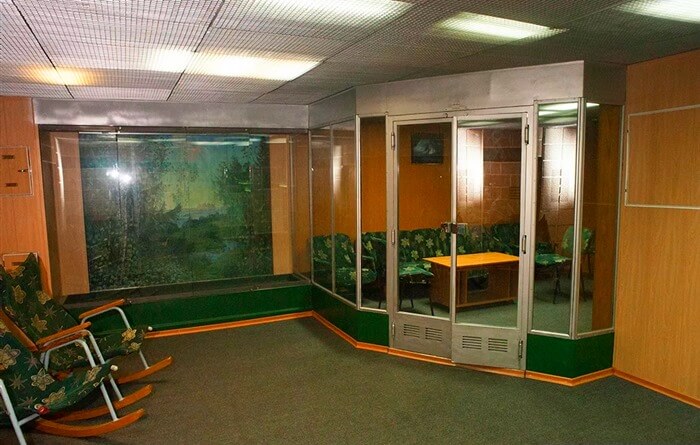 Instead of utilitarian steel furniture with minimal upholstery, the Akula's interior features comfortable upholstered chairs, full-size doorways, a fully equipped gym, a fresh or saltwater pool, a solarium, and even an oak-paneled sauna. The command cabins have televisions, washbasins, and air conditioning.
Instead of utilitarian steel furniture with minimal upholstery, the Akula's interior features comfortable upholstered chairs, full-size doorways, a fully equipped gym, a fresh or saltwater pool, a solarium, and even an oak-paneled sauna. The command cabins have televisions, washbasins, and air conditioning.
The triumph of the huge and fearsome Akulas, however, was short-lived. Of the seven planned submarines, six were built during the 1980s and retired less than 10 years later, in the 1990s. The Russian government simply could not afford to keep these largest missile submarines in the world operational.
 Currently, only one modernized Akula, the TK-208 Dmitry Donskoy, is in service. The largest submarine in the world serves as a test site for modern submarine-launched ballistic missiles (the Bulava SLBM).
Currently, only one modernized Akula, the TK-208 Dmitry Donskoy, is in service. The largest submarine in the world serves as a test site for modern submarine-launched ballistic missiles (the Bulava SLBM).

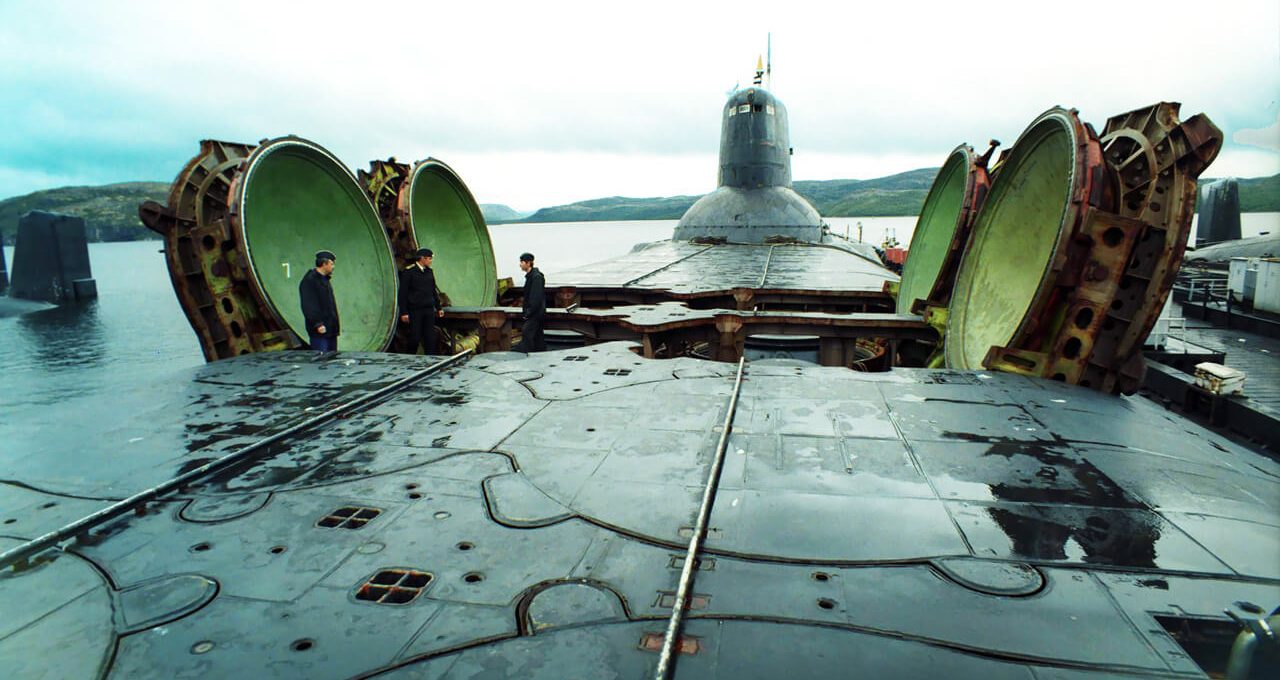





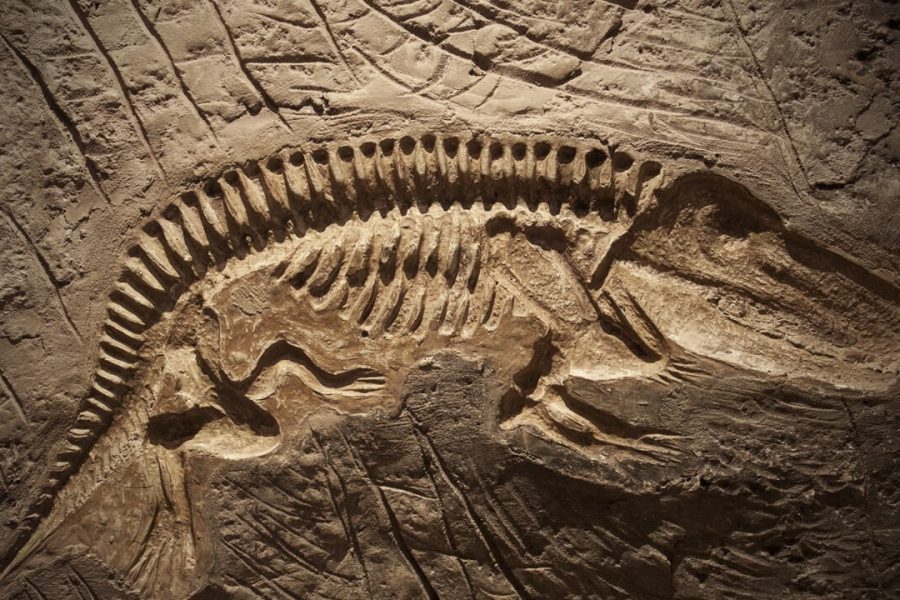



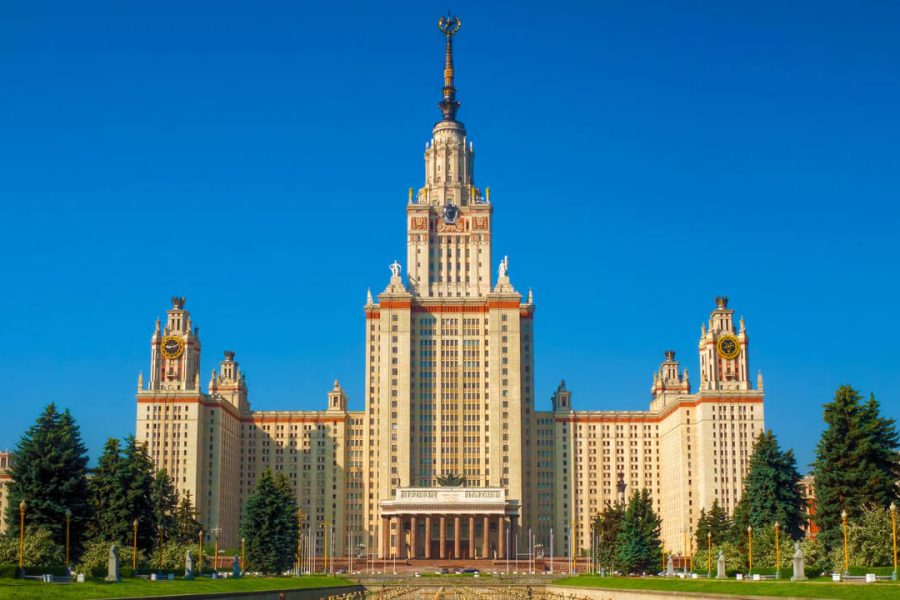


Оставить Комментарий